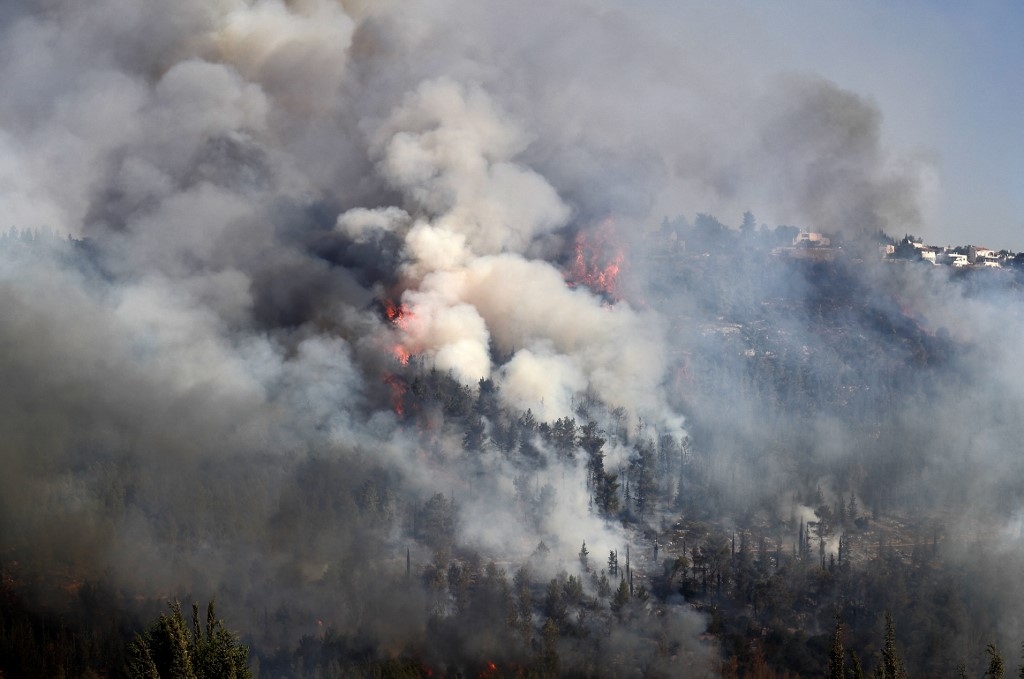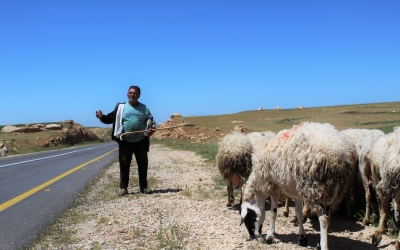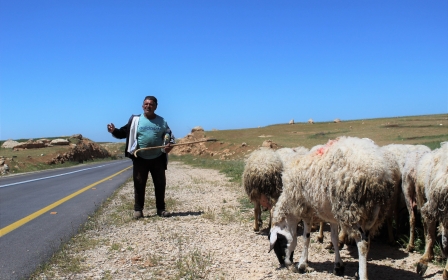Why the climate movement must support the Palestinian cause

The summer of 2021 will be remembered for giving a grim glimpse of the future that may lie ahead for the Mediterranean region.
In late July - the world's hottest month ever recorded - scorching temperatures contributed to the outbreaks of deadly wildfires in Turkey, joined in early August by conflagrations in Greece. Unforgettable images captured communities staring in disbelief, as they were evacuated in boats from their homes as flames engulfed forests along the Mediterranean coast.
New MEE newsletter: Jerusalem Dispatch
Sign up to get the latest insights and analysis on Israel-Palestine, alongside Turkey Unpacked and other MEE newsletters
On the other side of the Mediterranean Sea, wildfires broke out in several regions of Algeria, with a similarly devastating impact. On 15 August, fires began to spread through forests west of Jerusalem, with photographers capturing ominous clouds of black smoke over the city’s iconic al-Aqsa Mosque.
Whatever the immediate cause of the fires in all these locations, the science unequivocally points to one factor that threatens a catastrophic situation: human-induced global warming. The Mediterranean region is particularly threatened by climate change, experiencing an increase in temperatures 20 percent faster than the global average, expected to lead to intense heatwaves, droughts and declining agricultural production.
The decline of water resources is a particular problem, with demand from a growing population expected to double or even triple by 2050.
While the report of the Intergovernmental Panel on Climate Change, released in August, highlighted the dire outcomes for everyone should humanity not make the sweeping changes necessary to avert a two-degree rise in global temperatures, it is clear that Mediterranean communities, and especially the most marginalised, will be among those hit first and hardest.
Bitter irony
Heightening Palestinians’ exposure to climate change is the fact that, for millennia, the residents of the Fertile Crescent - a region of south-west Asia including Palestine - have built their way of life around settled agriculture.
It is no coincidence that some of the iconic symbols of Palestinian identity, including the olive tree, za‘atar or wild thyme, and the recently revived watermelon, are agricultural products. Yet existence in millennia-old agricultural villages will within decades be under threat from the effects of drought, criminally exacerbated by the effects of Israel’s occupation.
Every Palestinian olive tree that is uprooted by the Israeli military or burned by settlers, every square foot of fertile land taken for an illegal Israeli settlement or road, represent thousands of litres of precious water wasted. While food waste is widely recognised as a major driver of climate change, earlier in the summer Israel was happy to impose arbitrary demands on besieged Palestinian farmers in the Gaza Strip which meant that tonnes of Gaza’s tomato crop were threatened.
With a bitter irony, while committing these and many more violations of environmental and human rights, Israel has consistently attempted to portray itself as an environmentally aware nation, something critics have identified as “greenwashing”.
Israel has consistently attempted to portray itself as an environmentally aware nation, something critics have identified as 'greenwashing'
These are facts that climate activists in movements such as Extinction Rebellion - which has been consistently critiqued for ignoring the concerns of people of colour - must wake up to. For far too long, the environmentalist movement has been perceived as being dominated by middle-class white people in the global north, privileged individuals who have been too quick to point the finger of blame for climate change at “overpopulation” in the global south.
This factual and strategic error has placed the burden of guilt on the world’s poorest people - who have the smallest carbon footprint and environmental impact and also stand to suffer first and most heavily from climate change - and removed it from some of the largest polluters, corporations and the military-industrial complex in countries that frequently talk green, but do next-to-nothing or worse on the issue of the climate crisis.
Indigenous peoples
Today, these fictions can no longer be maintained. The particular challenges faced by the global south and marginalised communities of the global north, as well as the contributions made to the environmental movement by indigenous peoples, are plain to see. A key turning point was the 2016 protests at the Standing Rock reservation, when members of the Sioux tribe and mainly indigenous allies organised against the Dakota Access Pipeline.
Indigenous-led resistance to environmental destruction and fossil fuel extraction and transportation has continued in North America, with the 2020 protests against the Coastal GasLink pipeline which threatened the land of the Wet’suwet’en nation in British Columbia, and currently with actions in Minnesota against the construction of Line 3, a pipeline for infamously destructive tar sands oil, led by several Native American tribes.
Just as environmental activists have rallied to these causes, they must now make clear their solidarity with Palestinians. Like other indigenous peoples, Palestinians must face both the strains that climate change places on their way of life, and ongoing processes of colonisation that attempt to drive them from their land.
While the past century of Palestinians’ freedom struggle has revealed a people’s tremendous resourcefulness, strength and tenacity, it is clear that their cause requires the support of all who believe in justice - including, without a doubt, climate justice.
For many years, the Palestinian flag has been an indispensable part of demonstrations for social justice and a better world, from anti-war protests to refugee rights and Black Lives Matter. With preparations for a global day of action in November as world leaders meet for the COP26 summit in Glasgow, it is time for the climate movement to raise the flag of Palestine too.
The views expressed in this article belong to the author and do not necessarily reflect the editorial policy of Middle East Eye.
Middle East Eye delivers independent and unrivalled coverage and analysis of the Middle East, North Africa and beyond. To learn more about republishing this content and the associated fees, please fill out this form. More about MEE can be found here.








